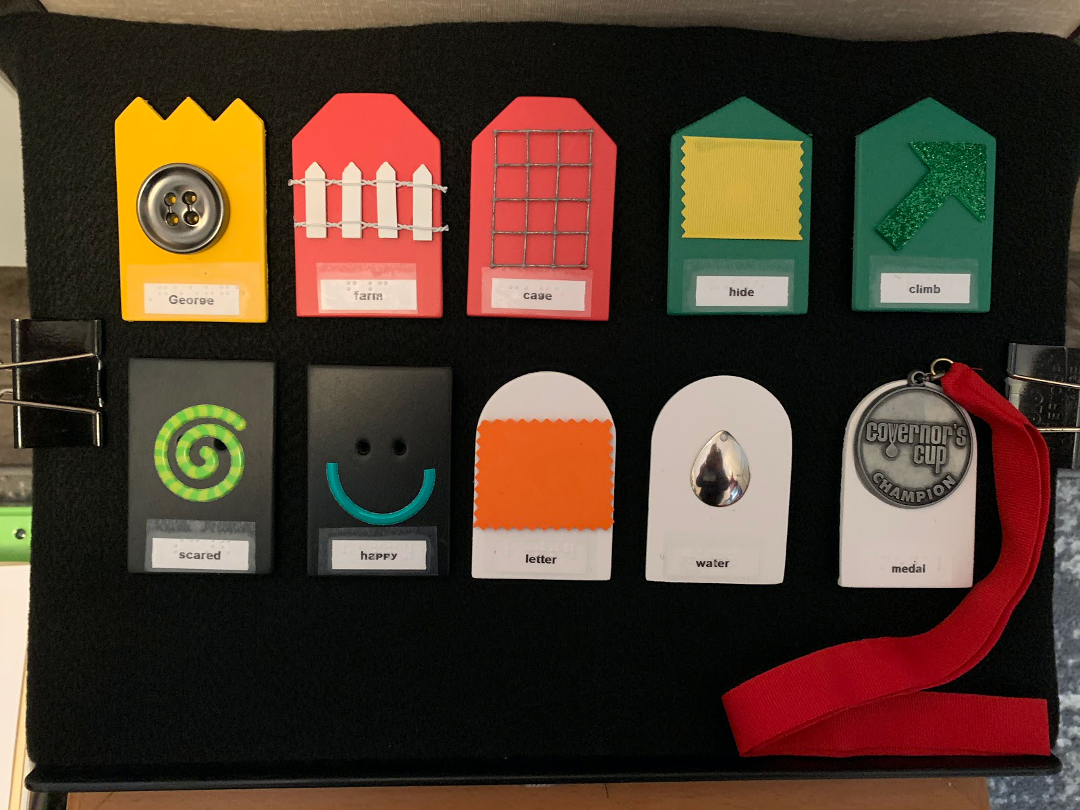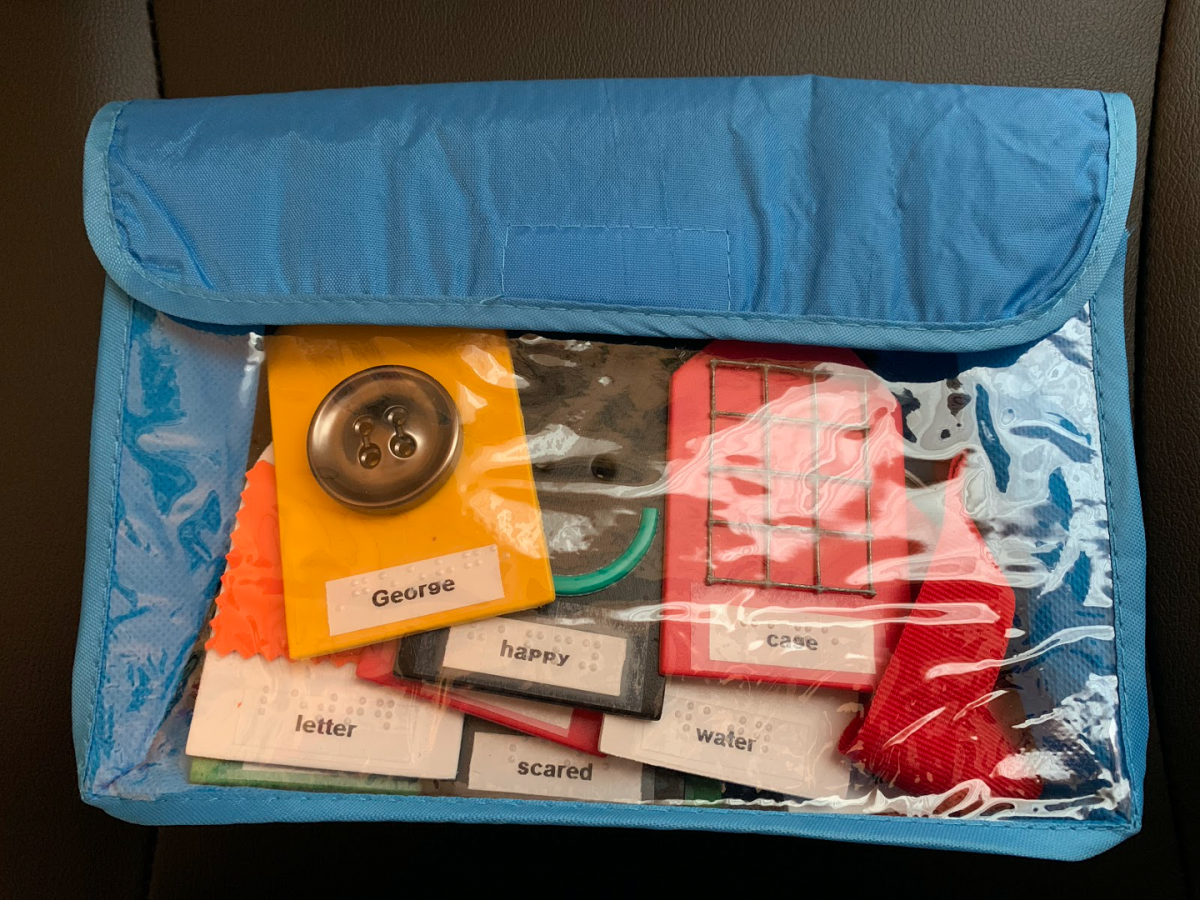As part of the graduate coursework for Visual Impairments and Multiple Disabilities in the Teacher Preparation Program in Visual Impairments at the University of Kentucky, students were asked to complete four projects: a Story Box with at least 10 objects that correspond to the story, picture communication symbols and tactile communication symbols designed to go along with the story, and a talking book to go along with the story or represent concepts from the story.
We are sharing them on Paths to Literacy and hope that others will use them!
I chose Curious George Gets a Medal by H.A. Rey because Curious George is a common character who is always getting into mischief. Students with complex needs can continue to build on a character and look at the various stories based around them. This helps to create a strong foundation for literacy skills. The books are often simple in color scheme using red and gray scales with yellow. Reducing the visual clutter will allow students with some vision to utilize what they do have. George’s adventures also lend themselves to concept-building activities for students with no vision.
Story Box
I chose the following objects for the Story Box:
-
Curious George Doll: Curious George is a monkey, unlike any other monkey. Students could explore and feel his shape. At one point in the story George has to be “as still as a stuffed animal.” This would be an excellent opportunity to discuss comparisons and similes.
-
Letter: George receives a letter at the beginning of a story. As an extension, you going bring in various pieces of mail so they can learn that letters come in different shapes and sizes.
-
Powdered Soap: Many children won’t have experience with powder soap that comes in a box. As an extension, you could take powder soap and let the students see how it reacts with water and discuss the concept of “lather.”
- Garden Hose: George pulls the garden hose in through the window because he needs to clean his mess with soap and water. Different nozzles are available and talk with students to activate any background knowledge.
- Latch: I would create an interactive board with various types of latches and let the child explore. There are many different types. I would discuss what the purpose of the latch his. The students can interact and feel the hinges and learn that the latch locks something close.
- Fur: I would let the students explore the feel of the fur. Ask the student what other types of animals feel like. Linking to any background knowledge from having pets, etc.
- Clothespin on Line: Many people will hang clothes on the line with clothespins to try laundry instead of using a dryer. George hid in a shirt that was hanging outside to dry.
- Coconut Shell: George climbed the palm tree to get to the coconuts. Many students will not have knowledge of what coconuts look like. Students can feel the shell. When teaching it, I would also bringing in a fresh coconut so they can hear the liquid inside. Discuss that coconuts are a type of fruit that grow on palm trees.
- Crate/Cage: Discuss the various reasons a crate might be used. Talk about the different sizes they can come in. Do they have a pet that has a crate/cage?
-
Medal: George earns a medal for being a brave monkey. Why else might someone receive a medal? Let the child wear the medal and explore the concept.

Implementation
- Sequencing: Have the students sequence the objects as they appear in the story. This will also help with listening/reading comprehension.
- Vocabulary: Introduce the students to new terms including the concept of synonyms (eg: cage vs. crate)
- Inferencing: Pause throughout the story and ask higher level questions and ask the students to make inferences based on what they know. Many students struggle with the concept of inferencing so this skill needs to be taught intentionally.
- Prediction: Have the students make predictions throughout the text and have them go back and evaluate their predictions for accuracy. (eg: What do you think will happen when George adds water to the soap?)
- Writing: Allow the students to write an extension of what they think will happen to George next. They could also write alternatives within the story. (eg: George didn’t bail out of the spaceship because he got scared, what happens next?)
Tactile Symbols
To make this accessible for a slant board, the felt is held on with binder clips. When not in use, it can be folded up and stored with the tactile symbols. The student this was designed for is already accustomed to a slant board. When the felt is attached, it will signal that they are about to work on a story.

The symbols and background can all be stored in this pouch which fits nicely into the story box with the objects and book.

Picture Symbols
I chose symbols that would represent key items within the story. I kept symbols in one category to help with sequencing activities. As an extension, I would include emotion and action symbols for this story. Since my students are not cognitively ready for more than one category, I wanted to focus on the objects that are important within the story. It will be important to work through concept development with each item. The George symbol will be one that is familiar, especially as I introduce more books about Curious George. As my students show growth, I would add symbols from other categories. We would begin with emotion and/or action symbols in isolation. We would eventually work towards integrating all symbols together with the intent that the student could sequence, identify nouns, verbs, and emotions, and sort into categories.

- George: George is the main character. He is always getting into some type of mischief and adventure. Discuss background of knowledge and ask if they know who Curious George. Talk about what the word “curious” means.
-
Letter: The story starts with the mailman bringing George a letter. There is a problem though, George doesn’t know how to read. He decides to try to write a letter of his own.
- Have you ever gotten a letter?
- Practice by writing a letter to someone.
- ECC trip to a post office to learn about letters and mail delivery.
-
Hose: After making a mess with ink, George decides to use powder soap and water to clean his mess. He pulls the garden hose in through the window.
- Have you used a garden hose? What does it do?
-
How could George have cleaned up the mess instead?
-
Lake: George realizes he has made a mess and the room looks like a lake, full of water.
-
Introduce the concept of simile: If George compared the room to a lake, what did he really mean? Discuss other possible similes.
-
What might a lake be used for? (fishing, boating, swimming, etc.)
-
-
Farm: George realizes that he needs to borrow a pump to get the water out of the house. He has seen one at the farm next door.
-
Have you been to a farm? What kinds of things might be on a farm?
-
Are all farms the same? How are they different?
-
-
Museum: After getting into trouble with the farmer, George jumps on a truck and travels to a museum. He has never been to a museum before.
-
Have you ever been to a museum?
-
What else might you see at a museum?
-
*ECC trip to a museum to explore.
-
-
Cage: George creates a mess in the museum and is caught. The guards catch him and put him in a cage to take him to Professor Wiseman.
-
Do you have an animal that has a cage or a crate?
-
What are different reasons an animal might be in a cage or crate?
-
-
Rocket: Professor Wiseman was happy to see George because he was needing his help. He was willing to forgive George for making a mess if he agreed to go in a rocket ship and bail out.
-
Where was the rocket headed?
-
Is there another word for a rocket?
-
-
Parachute: When George bails out of the rocket, he uses a parachute to float down safely. I would need to make connections as to what a parachute does, how big it really it, and how it functions.
-
Why does George need a parachute?
-
Who else might need a parachute?
-
-
Medal: People cheer and welcome George. He is a hero. Professor Wiseman gives him a medal for being the first monkey in space.
-
Why is a medal important?
-
Who else might receive a medal? Why?
-





